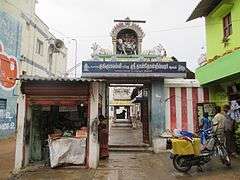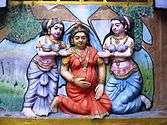Thanthodreeswarar Temple, Woraiyur
| Thanthoneeswarar Temple | |
|---|---|
 | |
 Thanthoneeswarar Temple Location in Tamil Nadu | |
| Geography | |
| Coordinates | 10°22′N 78°51′E / 10.367°N 78.850°ECoordinates: 10°22′N 78°51′E / 10.367°N 78.850°E |
| Country | India |
| State | Tamil Nadu |
| District | Tiruchirapalli |
| Location | Woraiyur |
| Culture | |
| Primary deity | Thanthoneeswarar |
| Architecture | |
| Architectural styles | Dravidian architecture |
Thanthoneeswarar Temple is a Hindu temple dedicated to Shiva, located in Woraiyur, a suburb in the town of Tiruchirapalli in Tamil Nadu, India. The temple was built by the Pandya ruler Varaguna Pandiyan II during the 9th century.
It has inscriptions dating back to 885 AD during the rule of Cholas. The temple has six daily rituals at various times from 5:30 a.m. to 8 p.m., and three yearly festivals on its calendar. The temple is maintained and administered by hereditary trustees.
Etymology and legend
Thanthoneeswarar, the presiding deity of the temple, derives its name from Tamil word Thanthondri, meaning the one who formed on his own. As per Hindu legend, Chola queen Kanthimathi was an ardent devotee of Shiva and worshipped Shiva in Thayumanavar swamy Temple. When she was pregnant, she could not climb the hill to reach the temple. Shiva was pleased by the devotion of the queen and is believed to have appeared to her in the form of lingam (an iconic form of Shiva) at this place on his own and blessed her with a safe delivery.[1]
Architecture

The temple was built by the Pandya ruler Varaguna Pandiyan II during the 9th century. It has inscriptions dating back to 885 AD during the rule of Cholas. The temple, in modern times, is maintained and administered by hereditary trustees.
Thanthoneeswarar temple complex has a single prakaram (outer courtyard) and a two-tiered vimana (tower over the sanctum). The central shrine faces east and holds the image of Thanthoneeswarar (Shiva) in the form of lingam made of granite. The granite images of the deities Ganesha (son of Shiva and god of wisdom), Murugan (son of Shiva and god of war), Nandi (the bull and vehicle of Shiva) and Navagraha (nine planetary deities) are located in the hall leading to the sanctum. As in other Shiva temples of Tamil Nadu, the first precinct or the walls around the sanctum of Thanthoneeswarar has images of Dakshinamurthy (Shiva as the Teacher), Durga (warrior-goddess) and Chandikeswarar (a saint and devotee of Shiva). The shrine of Kunkumavalli, the consort of Thanthoneeswarar, faces North and is depicted with Ankusam and lotus in her two hands. The temple precinct is surrounded by granite walls.[1]
Worship and religious practises

The temple priests perform the puja (rituals) during festivals and on a daily basis. Like other Shiva temples of Tamil Nadu, the priests belong to the Shaiva community, a Brahmin sub-caste. The temple rituals are performed six times a day; Ushathkalam at 5:30 a.m., Kalasanthi at 8:00 a.m., Uchikalam at 10:00 a.m., Sayarakshai at 5:00 p.m., Irandamkalam at 7:00 p.m. and Ardha Jamam at 8:00 p.m. Each ritual comprises four steps: abhisheka (sacred bath), alangaram (decoration), naivethanam (food offering) and deepa aradanai (waving of lamps) for both Thanthoneeswarar and Amman. The worship is held amidst music with nagaswaram (pipe instrument) and tavil (percussion instrument), religious instructions in the Vedas (sacred texts) read by priests and prostration by worshippers in front of the temple mast. There are weekly rituals like somavaram (Monday) and sukravaram (Friday), fortnightly rituals like pradosham and monthly festivals like amavasai (new moon day), kiruthigai, pournami (full moon day) and sathurthi.[2]
References
- 1 2 V., Ganapathy (4 November 2004). "Siva temple of yore". The Hindu. Retrieved 2013-09-09.
- ↑ "Sri Kungumavalli Sametha Thanthondreeswarar temple". Dinamalar. 2014. Retrieved 24 November 2015.
External links
| Wikimedia Commons has media related to Thanthodreeswarar Temple, Woraiyur. |


